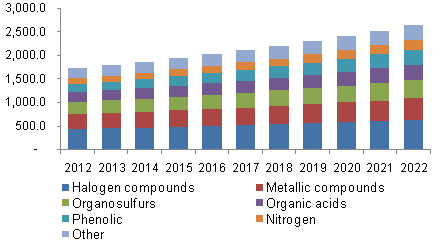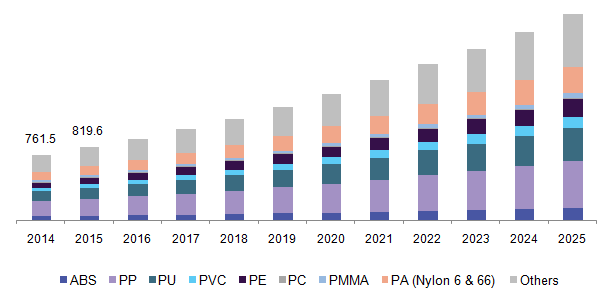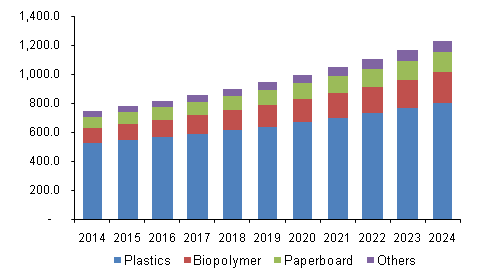 By Varun Juyal
By Varun Juyal
According to a report by Grand View Research, Inc., the global biocides market is projected to reach USD 10,745.7 million by 2020. Growing requirement for clean drinkable water coupled with treatment of waste water from industries is anticipated to propel the market over the forecast years (2014 to 2022). Biocides can control or destroy harmful organisms present in water through chemical or biological process. Application growth of biocides in paints & coatings, personal care and water treatment account for gains in key industrial segments including automotive, construction and consumer goods in emerging economies including China and India.
Need to find biocidal materials?
UL Prospector® has listings for hundreds of biocidal materials for use in multiple applications. Find technical data, request samples, and contact global suppliers with your free account.
Register now
High demand for potable water in industrial and domestic applications owing to increasing population is anticipated to propel market growth. Growing adoption of water treatment processes owing to rising demand for clean water can further fuel the market for biocides. Stringent government policies regarding waste water treatment coupled with enhanced healthcare expenditure can foster growth of the market during the forecast period.
Global Biocides market revenue, by product, 2013

The worldwide biocides market can be segregated on the basis of product, application, and region. Based on product, the market can be classified into metallic compounds, halogen compounds, organosulfur, organic acids, nitrogen, phenolic, and others. In 2014, the halogen compounds segment dominated the global market accounting for around 25 percent of the overall revenue generated in that year. This trend is predicted to continue during the forecast period. Easy availability and low cost of raw materials for halogens such as iodine, bromine, and chlorine are anticipated to impel the growth.
On the other hand, the metallic compound segment generated more than USD 1.5 billion as revenue in the year 2014. They can be used as disinfectants in water treatment plants and cooling towers. High demand for clean water is expected to impel demand for metallic compounds in the coming years. In addition, stern government regulations against the use of halogens is likely to fuel demand in near future.
Organosulfurs accounted for 11 percent of total share of the global biocides market in 2014. Such biocides can be used in healthcare application to inhibit microorganism growth on metal and plastic surfaces owing to antibacterial and antifungal properties. High demand for plastics in automotive and construction can spur growth of the market during the forecast period.
U.S. automotive plastics market volume by product, 2014 – 2025 (Kilo Tons)

Based on application, the market can be segmented into food and beverage, personal care, water treatment, wood preservation, paints and coatings, and others. In 2014, water treatment applications accounted for 23 percent of total market share in terms of revenue. High demand for microbial activity, scaling, corrosion, and disposal in water treatment can influence demand in the forthcoming years.
On the other hand, food and beverage applications accounted for around USD 1.48 billion in the year 2014. Growing adoption of preservatives in ready-to-eat food products and rising demand to control microbial growth in food and drinks can impel demand for biocides by 2022.
U.S antimicrobial packaging market volume by base material, 2012 – 2024 (Kilo Tons)

In personal care applications, the market is predicted to exhibit growth at CAGR of 5.4% during the forecast period. Growing use of cosmetic products such as shower gel, liquid soap, shampoo to get rid of bacteria and fungus is projected to have a strong impact.
Regional segmentation includes Europe, North America, Asia Pacific, and rest of the others (ROW). In 2014, North America accounted for around 40 percent of overall revenue share. High demand for paints and coatings owing to infrastructural and building development is likely to influence the regional market growth during the forecast period.
In Asia Pacific, the market for biocides is anticipated to witness significant growth in the coming years. It can grow at CAGR of more than 6% from 2015 to 2022. Growing healthcare expenditure owing to low-cost medical facilities and technological advancements can spur demand for phenolic in the region.
Key biocide manufacturers include Dow Microbial Control, Troy Corporation, Thor Specialties, BASF, and Clariant. Most companies are expected to input huge investment at initial stage owing to tough government policies regarding labeling and testing of biocides before and after placing them in the market. This can obstruct entry of new players in the market during the forecast period.
About the Author
 Varun Juyal holds a Bachelors in Petroleum Maintenance & Operations and M.B.A in Oil & Gas Management from University of Petroleum Studies, Dehradun. He has more than four years of experience in market research and business consulting. Varun has been an active participant in a majority of the consulting engagements, product sales forecasting, and penetration studies at Grand View Research. Clients in paints & coatings, construction, oil & gas and chemical sectors have appreciated his consulting projects and in-depth research coverage. Working for over three years in business consulting, specifically in paints and coatings, has provided him with key attributes for a comprehensive understanding regarding consumer requirements and delivering detailed research-oriented solutions.
Varun Juyal holds a Bachelors in Petroleum Maintenance & Operations and M.B.A in Oil & Gas Management from University of Petroleum Studies, Dehradun. He has more than four years of experience in market research and business consulting. Varun has been an active participant in a majority of the consulting engagements, product sales forecasting, and penetration studies at Grand View Research. Clients in paints & coatings, construction, oil & gas and chemical sectors have appreciated his consulting projects and in-depth research coverage. Working for over three years in business consulting, specifically in paints and coatings, has provided him with key attributes for a comprehensive understanding regarding consumer requirements and delivering detailed research-oriented solutions.
The views, opinions and technical analyses presented here are those of the author or advertiser, and are not necessarily those of ULProspector.com or UL Solutions. The appearance of this content in the UL Prospector Knowledge Center does not constitute an endorsement by UL Solutions or its affiliates.
All content is subject to copyright and may not be reproduced without prior authorization from UL Solutions or the content author.
The content has been made available for informational and educational purposes only. While the editors of this site may verify the accuracy of its content from time to time, we assume no responsibility for errors made by the author, editorial staff or any other contributor.
UL Solutions does not make any representations or warranties with respect to the accuracy, applicability, fitness or completeness of the content. UL Solutions does not warrant the performance, effectiveness or applicability of sites listed or linked to in any content.



Very informative post related to clinical research. It is great help for my new project .By reading this article, I learn some important things that I need to improve. I continuously check this site for regular updates in field. Thanks for putting top notch content in article. I would like to be here again to find another masterpiece article.